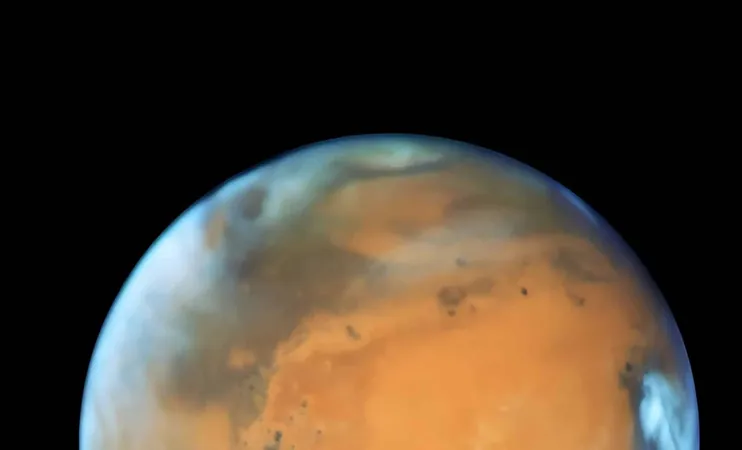
Titan: The Earth-Like Moon That Could Rewrite Our Understanding of Life
2025-05-20
Author: Wei
Titan's Stunning Similarities to Earth
In a groundbreaking discovery, scientists utilizing the James Webb Space Telescope and the Keck II telescope in Hawaii have unveiled astonishing weather phenomena on Titan, Saturn's largest moon. For the first time, clouds are forming and rising over Titan's Northern Hemisphere, an area rich with extensive lakes and seas filled with liquid methane and ethane.
A Chilling Mystery 880 Million Miles Away
Titan, located approximately 880 million miles from Earth, is a bizarre, frigid world enveloped in a thick, yellowish haze with temperatures plummeting to -300 degrees Fahrenheit. Yet, despite its harsh climate, Titan's atmosphere intriguingly mirrors that of Earth, being predominantly nitrogen. This striking similarity has captivated scientists who suspect that Titan experiences a weather pattern akin to Earth's water cycle—only with methane instead of water.
Clouds on Titan: A Thunderous Transformation?
By analyzing data collected over several days, researchers captured the remarkable phenomena of cloud convection near Titan's North Pole, where many of its liquid bodies are found. Observing these clouds evolve strongly suggests that methane rain might be replenishing the moon's lakes, mirroring Earth’s summer storms. NASA research scientist Conor Nixon, leader of the study published in *Nature Astronomy*, stated, "We were able to see methane clouds evolving and changing close to Titan’s North Pole over multiple days." This compelling observation reinforces the hypothesis that Titan is undergoing its own form of precipitation.
The Secrets Hidden in Titan's Atmosphere
Further intrigue comes from the Webb telescope's detection of the methyl radical in Titan’s atmosphere—a highly reactive molecule that hints at ongoing chemical reactions. On Earth, similar molecules are associated with the origins of life, raising the tantalizing possibility that Titan could support organic chemistry. Nixon noted that methane might be constantly replenished from Titan's crust, preventing it from becoming a barren world devoid of atmosphere.
NASA's Upcoming Dragonfly Mission: A Game Changer
Titan's eerie allure extends beyond its weather; it possesses essential organic ingredients thought to be necessary for life. This has propelled Titan to the forefront of exploration priorities, with NASA's ambitious Dragonfly mission set to explore the moon in the 2030s. The mission aims to deploy a helicopter-like drone that will investigate Titan's landscape and chemistry directly.
Cloud Heights: Titan's Unique Meteorological Features
One of the remarkable findings from the recent observations is the altitude at which clouds form on Titan. Thanks to the moon's lower gravity, its troposphere—the lowest atmospheric layer—extends up to 28 miles, significantly higher than Earth's 7.5 miles. This unique atmospheric trait influences the development of weather patterns, with solar heat driving the rise of methane clouds during the Northern Hemisphere's summer.
Looking Ahead: Titan's Evolving Weather Patterns
Researchers are excited about future observations, particularly after Titan’s upcoming equinox, to gain deeper insights into how the moon's extraordinary weather patterns shift with the changing seasons. Titan's uncanny resemblance to Earth continues to challenge our understanding of life and the potential habitats beyond our planet.





 Brasil (PT)
Brasil (PT)
 Canada (EN)
Canada (EN)
 Chile (ES)
Chile (ES)
 Česko (CS)
Česko (CS)
 대한민국 (KO)
대한민국 (KO)
 España (ES)
España (ES)
 France (FR)
France (FR)
 Hong Kong (EN)
Hong Kong (EN)
 Italia (IT)
Italia (IT)
 日本 (JA)
日本 (JA)
 Magyarország (HU)
Magyarország (HU)
 Norge (NO)
Norge (NO)
 Polska (PL)
Polska (PL)
 Schweiz (DE)
Schweiz (DE)
 Singapore (EN)
Singapore (EN)
 Sverige (SV)
Sverige (SV)
 Suomi (FI)
Suomi (FI)
 Türkiye (TR)
Türkiye (TR)
 الإمارات العربية المتحدة (AR)
الإمارات العربية المتحدة (AR)